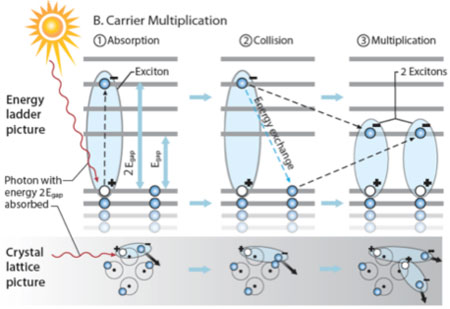Advanced Optical Spectroscopy
The topics of our spectroscopic studies include multiexciton phenomena in nanocrystals such as Auger recombination and carrier multiplication (multiexciton generation by single photons), spin- and energy- structure of band-edge excitonic states studied via single-nanocrystal and magnetic-field spectroscopies, energy transfer in engineered nanoassemblies including “wireless” excitation of nanocrystals via dipole-dipole coupling, charge transfer in nanocrystals coupled to molecular species, new concepts for nanocrystal lasing, light-emitting diodes, and photovoltaics, exchange interactions in magnetically doped nanocrystals, and exciton-plasmon interactions in hybrid semiconductor-metal nanoassemblies.
As part of our activities within the Center of Advanced Solar Photophysics (CASP), we explore the unique physics of nanostructured materials to boost the efficiency of solar energy conversion through novel light-matter interactions, controlled excited-state dynamics, and engineered carrier-carrier coupling. Examples of phenomena that are studied in the Center include field enhancement in metal nanostructures for improved light-harvesting and high-efficiency coupling schemes, quantum confinement in semiconductor for tailoring absorption spectra and directional transport in energy-gradient assemblies, strong electron–electron interactions in quantum confined materials for increased photogeneration rates via carrier multiplication. 
In our spectroscopic studies we apply the most advanced methods of ultrafast, single-nanostructure, and magnetic-field spectroscopies. Our spectroscopy labs are equipped with 5 amplified femtosecond lasers (supplemented by 7 parametrical optical amplifiers) coupled to systems for ultrafast transient absorption and femtosecond photoluminescence up-conversion. We have numerous systems for various single-nanocrystal spectroscopies including micro-photoluminescence and photoluminescence excitation, two-photon correlation, high-magnetic-field spectroscopy, sub-wavelength near-field extinction spectroscopy, and time-resolved measurements in the infrared using single-photon superconducting nanowire detectors. We are also developing a new unique instrument for high-spatial resolution optical spectroscopy combined with scanning tunneling microscopy (optical STM).
